When I first got into the world of SEO, you could literally optimize your site for any term and rank at the top of Google within a month or two.
But of course, that was ages ago.
Now with Google’s ever-evolving algorithm, it takes more time and effort to get results.
But what happens if you don’t have the luxury of time? Or you don’t have the financial resources to put in the effort that is truly needed.
What should you do?
Just forget about SEO?
Of course not. Today, I want to call out 11 tools that will help you get an edge over your competition. But unlike most lists, I am going to get very specific on the feature I want you to use within each tool to make your life easier and help you get results faster with less effort.
Let’s dive right in.
Tool #1: Ubersuggest Projects
You probably already know about Ubersuggest, but do you really have time to spend hours and hours each week to do your SEO?
Chances are you don’t.
So how do you improve your traffic with the least amount of effort?
You set up a project in Ubersuggest.

As you can see, it shows your SEO traffic over time. It will let you know if your rankings are going up or down, your link growth, and your SEO issues.
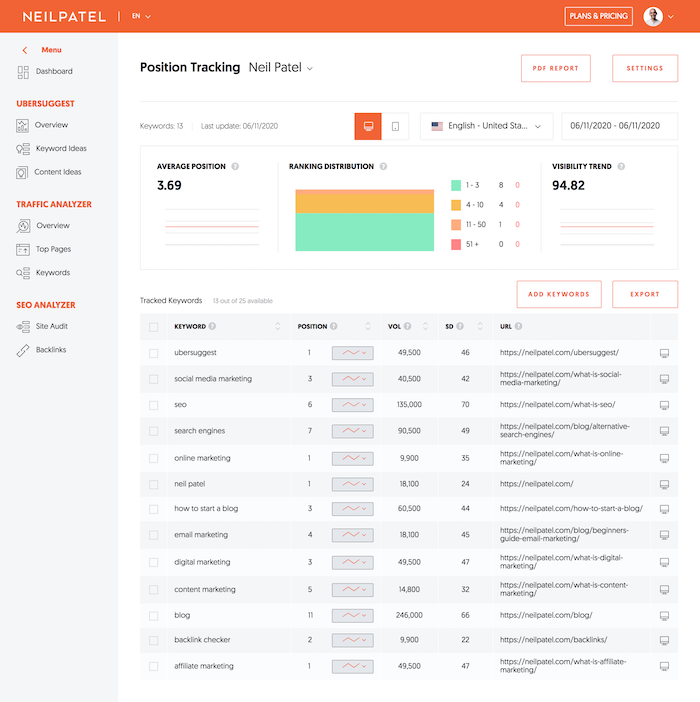
With so many things going on in marketing, you don’t have time to manually check your rankings or if things are going up or down or even what you need to fix.
Ubersuggest will do it for you all automatically and even notify you of what needs to happen through email. That way you don’t have to constantly check your SEO. Ubersuggest will do it all automatically.
More so, you’ll get notified of what you need to focus on each week to maximize your traffic.
All you have do is head to the dashboard and click on “Add Your First Project.”
It’s as simple as adding in your URL.

Then select the locations you do business in and want traffic from.

Then add in the keywords you currently rank for or want to go after.

And of course, set up your traffic preferences.

And then you’ll be good to go.
Then when things go great, you’ll be notified. And when things are going wrong, you’ll also be notified. Ubersuggest will even tell you what to fix.
That way you get the maximum results in the least amount of time.
Tool #2: Google Analytics Alerts
You have Google Analytics set up on your site, but how often do you log in?
And when you do log in, do you know what to focus on or what to look at?
And if you do, do you know what to do with that data?
Google Analytics is a great tool, but you don’t want to waste hours and hours looking at reports. Instead, you want to spend your time doing and getting results.
But if you set up alerts in Google Analytics, you can save tons of time.
If you watch from the 6:33 mark, it will show you how to set up alerts. I added the whole video as it will teach you how to set up Google Analytics in general in case you don’t have goal tracking set it place.
Once you set up alerts, you’ll again get notified when anything good or bad happens. I usually have alerts set up for only when things go bad, so I know when I need to focus on fixing my marketing.
Tool #3: Trello
You’re probably thinking how the heck is Trello a marketing tool. It really isn’t, but it is a good project management tool.
And with your SEO, you may have a team helping you out and Trello will help streamline the process, make you more efficient, and get your results faster.

I keep my Trello board simple by breaking it into 3 sections.
- To do – what needs to be done over time.
- Prioritized – what I need to be done now (tasks at the top are the most important)
- Done – tasks that need to be double-checked to ensure they were done right.
It’s that simple. That way you don’t have to micromanage your team.
Some people have more complex Trello boards, but something simple like I have worked too.
If you want to create a Trello board for your content marketing, assuming you want to write lots of content (such as 10 posts a week), this process works well.

The columns I use for content writers are:
- Topics – this is where writers add topics they want to write about.
- Outline review – writers submit their outline before they write for approval.
- Draft – writers submit their rough draft.
- Draft review – editors review each draft.
- Uploaded, prepared, and ready to review – this is where the editor adds the post to your CMS (like WordPress).
- Scheduled – this is where you schedule the content to go live.
- Done – the content is now live.
We’ve found it effective if you are managing dozens of writers at once.
Tool #4: Content Decay Tool
Can you guess how many articles I write each week?
1.
Seriously, that’s it. 1 article a week which is roughly 4 to 5 per month (depending on how many weeks in the month).
And can you guess how many articles my team and I update each week?
21.
That’s roughly 90 a month.
Just think about it… why would I have a team of 3 people updating 90 articles per month when I only write 1 a week.
It’s because updating old content is an easier way to get more SEO traffic than it is to create new content.
But what content should you update?
The content decay tool will tell you that.
It breaks down in order which articles you should update first, second, third… based on what will generate you the most traffic.
If you are wondering what is involved with updating content, just think of it this way:
- Is there anything outdated within your post – if so, either update the outdated information and make it relevant again. If you can’t, then delete that part from your article.
- Can you use media to improve the experience – do you need to embed videos, add more pictures, maybe even add an infographic? Use media to better tell your story and message.
- Are you including the right keywords – a simple way to get more traffic is to integrate other popular related keywords within your article. Whatever your article is about, insert it into Ubersuggest and head to the “Keyword Ideas” report in the left-hand navigation.
- Is there anything missing – try to poke holes within your content. What could you have done to make it better? What do your competitors talk about that you forgot to mention? What questions didn’t you answer that the reader might have? By asking yourself these simple questions, you’ll be able to make it better.
Tool #5: Ubersuggest Chrome Extension
If you haven’t installed the Ubersuggest Chrome extension, make sure you do so.
I’m not going to bore you with all of the features of the extension… instead, I am going to give you one thing that will save you time.
You know when you Google for information to learn more on any subject?
Chances are, sometimes you are Googling to learn something related to your space. And when you do, you’ll find that your site usually won’t be at the top of those search results.
And that’s ok.
But when you do a search, you’ll notice “monthly searches” in the Google search bar.

This shows you how often that keyword is searched.
So anytime you are looking up anything in your space, pay attention to that number. If you see a keyword with over 5,000 searches, it may be worth targeting.
And as you scroll down and start going through the sites that rank at the top, you’ll notice metrics under each site.
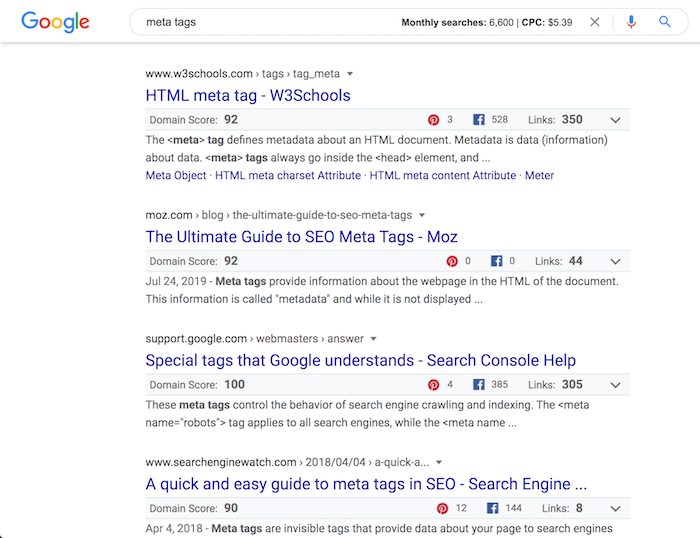
If you notice a web page with thousands of social shares and hundreds of links, it should reaffirm that you probably want to go after that term. And the listing that has thousands of social shares and hundreds of links is a good benchmark of a page that is high in quality and what people in your space prefer.
Ideally, you want to create something better than that one, as that is the main way you beat them over time.
Tool #6: Hello Bar
SEO is very different than paid traffic.
With paid traffic, you can drive people to a landing page with very little content, which makes it easier to generate sales or leads.
With SEO, Google prefers to rank content-rich sites.
But when someone lands on a page full of educational-based content, they are less likely to convert into a customer.
There’s a simple fix… Hello Bar.
Hello Bar has a lot of features, but I just want you to use the top bar like I do on NeilPatel.com.
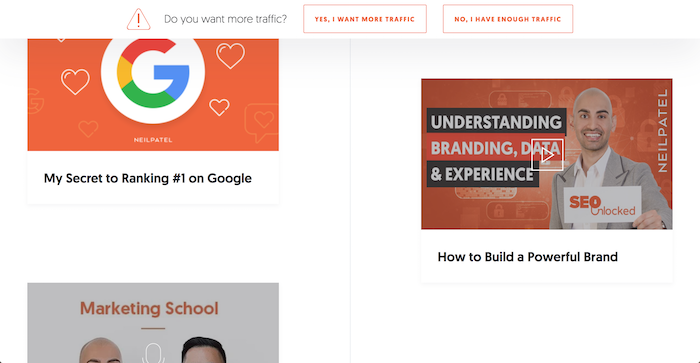
And as you scroll it moves along with you.
That one little thing allows me to improve my conversion rate from my SEO traffic.
You can easily adjust what you show with a few simple clicks within Hello Bar or you can even show people different messages based on where they are coming from.

Although SEO traffic doesn’t convert as well as paid traffic, it is much cheaper in the long run and does have a better overall ROI. And that one little Hello Bar will improve your numbers.
It’s responsible for 9.4% of revenue from NeilPatel.com.
Every little bit adds up.
Tool #7: Mozcast
Google makes over 3,200 algorithm changes a year.
Are you really going to keep up to date with all of them?
If you followed the first tool and set up a project in Ubersuggest, you’ll get notified when your rankings go down.
And if you set up alerts in Google Analytics (tool number 2) you’ll also get notified when your traffic drops drastically.
What you’ll find is that it’s overwhelming to keep up with all of Google’s updates and it could be confusing to figure out what you need to fix to get your traffic back.
This report on Moz keeps track of all of the algorithm updates and gives you an overview of what has changed or what the update is about. On top of that, you’ll want to check out the Mozcast if you get a notification of ranking or traffic drops as this tool confirms if other people are also seeing changes from a Google update.
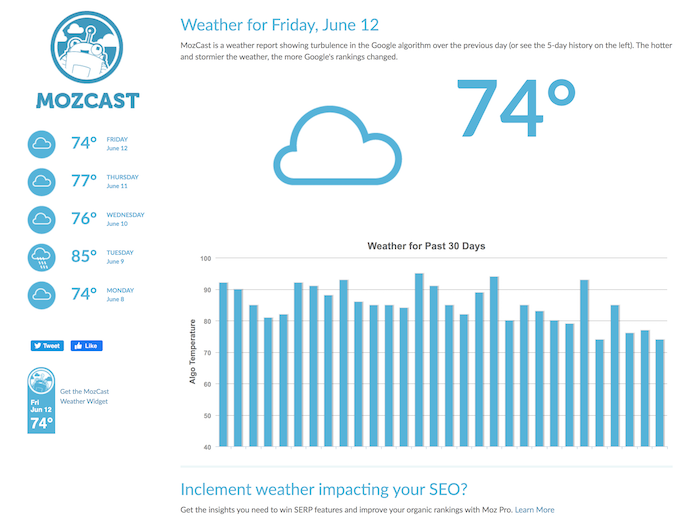
Keep in mind that Google doesn’t announce each update, hence you’ll want to cross-reference what you are seeing with the Mozcast.
That way you don’t have to spend hours researching each update.
Tool #8: Detailed
Link building is a pain. There are so many link tools like this one… but let’s not kid ourselves… you just don’t have the time to spend 10 to 20 hours a week doing link building.
So, each minute you spend, you have to make sure it counts.
There’s a tool called Detailed that breaks down the best links for every industry.
All you have to do is select an industry and a site and it shows you all of the good links that are going to your competition.

You can then focus your efforts on reaching out to those sites to get links.
Sure, you will still need to have amazing content or a good product or service in order to convince those sites to link to you, but hey, if you don’t have any of that it’s going to be hard to do well in the first place.
So, don’t waste your time trying to search for links when Detailed will give you a list of hundreds of amazing sites to get links from within your space.
Tool #9: Site Speed Audit
Speed impacts rankings.
Google doesn’t want to rank slow websites anymore.
It doesn’t matter that technology has become better and you can now purchase satellite Internet. Not every location has blazing fast Internet.
For that reason, Google has an Accelerated Mobile Pages framework that helps with mobile load time.
But that’s not enough, you also need your website to load fast.
So, go here and put in your URL.
You’ll then be taken to a report that looks like this:
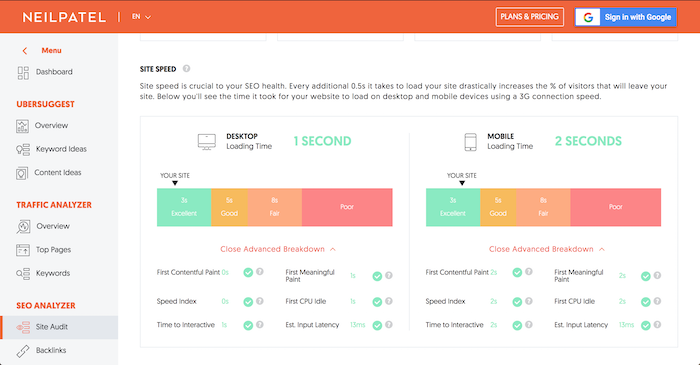
What’ll you want to focus on is site speed. That Ubersuggest report pulls from Google Lighthouse.
So, send that to your developer and tell them to get you in the green mark for both mobile and desktop load times.
As your speed goes up, so will your SEO rankings and traffic over time.
Tool #10: Supermetrics
Are you tired of having your data everywhere?
Why would you want to log into four of five different apps to get your SEO and marketing data when you could log into one.
And no, I am not talking about Google Analytics. I am talking about Google Data Studio.
If you haven’t used it yet, sign up for it… it’s free.
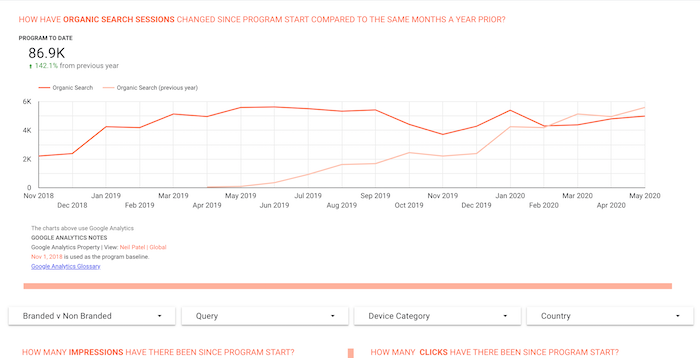
Google Data Studio is a business intelligence tool that will show you all of your data in one place.
So how do you get all of your SEO data into Google Data Studio? You use Supermetrics.
It passes all of your SEO data from different sources into Data Studio, so you no longer have to log into multiple tools, including Google Analytics.
My favorite feature in Supermetrics is you can automate your marketing reporting, so you no longer have to create your reports manually.
Tool #11: VidIQ
Google is the most popular search engine.
But do you know what the second most popular search engine is?
It’s not Bing… it’s actually YouTube, which Google actually owns.
If you haven’t done YouTube SEO yet, you should reconsider. Just look at how much search traffic I get from YouTube each month.
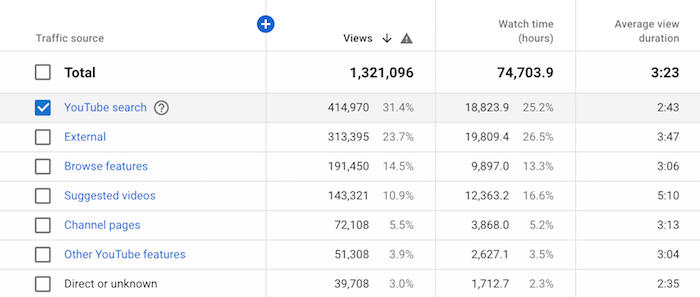
This article will break down how to do YouTube SEO if you want to learn how it works.
But to make things easier, install this Chrome extension.
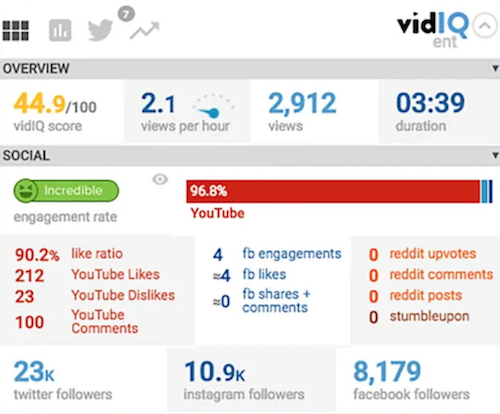
Whenever you perform a search on YouTube it will show you what’s popular, what keywords are being searched that are related to each video, and which tags people are using to get more SEO traffic.
I wanted to end this post with VidIQ because it’s not competitive.
See, unlike traditional SEO, it doesn’t take months to see results. YouTube SEO is the opposite in which it isn’t as competitive (yet) and you can rank at the top within 24 to 48 hours of releasing a video (seriously!).
Conclusion
They say SEO is hard and time-consuming. And I am not going to lie, you won’t get results unless you put in some effort.
But who says it has to be as time-consuming?
By using some of the tools I mentioned above you’ll save time. It really is that simple.
I know there is a lot and it can be overwhelming. So if you don’t have time to use all of the tools it is fine… just start at the top and work your way down (I put them in order based on what will save you the most time).
What other ways do you save time on your SEO?
The post The SEO Tool Kit: 11 Tools That’ll Save You Time appeared first on Neil Patel.

